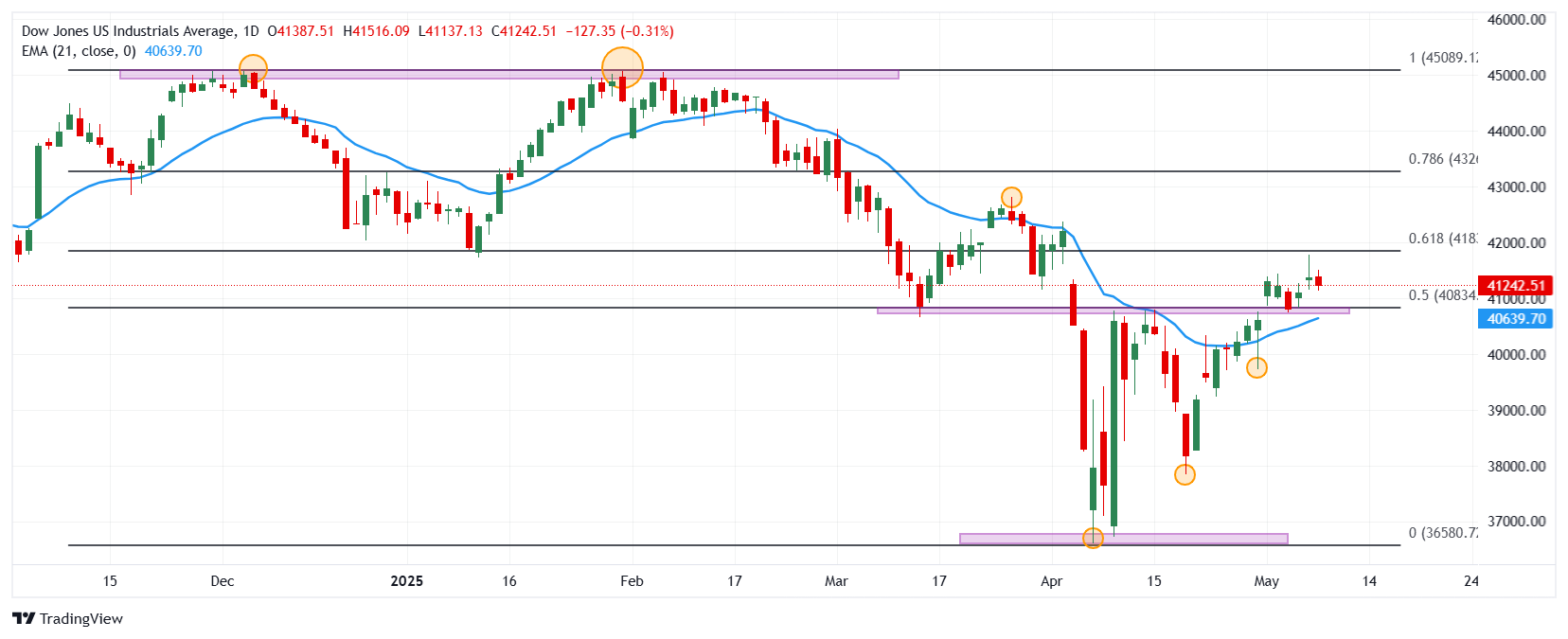- The Dow Jones falls 0.28% daily, consolidating within the operational range of May 8 in 41,255.
- The Nasdaq 100 goes back 0.09% today, dragged by Crowdstrike Holdings (CRWD).
- The S&P 500 loses 0.04% on Friday, weighed by Expedia Group (EXPE).
- The president of the New York Federal Reserve, John Williams pointed out in his speech today that his priority is to achieve price stability.
The Dow Jones marked maximum of the day in 41,516, attracting aggressive vendors that dragged the index to a minimum daily in 41,180.
The Dow Jones industrial average began operating in 41,387, while the Nasdaq 100 technological index began negotiations in 20,089. The S&P 500 opened in 5,669, operating in negative terrain on the last day of the week.
International Business Machines and UnitedHealth drag Dow Jones to loss zone
The Dow Jones index falls 0.28% today, reaching a minimum of the day in 41,180.
The actions of Unitedhealth (UNH) have a loss of 1.57% today, visiting minimal not seen since April 15, 2021 in 379.21 $, signing its fourth consecutive day downward.
The titles of International Business Machines (IBM) go back 2.14% daily, reaching May 6 at 247.64 $, spinning two consecutive days with losses.
In this context, Dow Jones slides to 172 points, ending with two consecutive days upwards, currently quoting over 41,175.
Crowdstrikeholdings and Palantir Technologies lead the losses in Nasdaq 100
The Nasdaq 100 technological index loses 0.09% daily, consolidating within the operational range of the previous session at 20,022.
Crowdstrikeholdings (CRWD) values fall 4.35% on Friday, today visiting April 24 at $ 404.63, leading losses in Nasdaq 100.
In the same tuning, the actions of Palantir Technologies (PLT) retreat 2.48% in the day, currently quoting about $ 116.25, ending with a streak of two consecutive days upwards.
The Nasdaq 100 falls 60 points today, reaching a minimum of the session at 19,998, quoting on negative terrain in tune with the main stock market indices.
The S&P 500 ppera with marginal losses on the last day of the week
Expedia (EXPE) shares have a fall of 7.44% today, visiting minimal not seen since April 30 at $ 148.55.
Expe published its earnings report today, obtaining income for 2.99 billion dollars compared to the 3.01 billion dollars expected by analysts, as well as a gain per share of 0.40 $ compared to the $ 0.352 provided by the market.
The S&P 500 loses 5 points today, four presenting a marginal loss of 0.04%, quoting when writing about 5,662, consolidating within the operational range of the previous session.
On the other hand, the president of the Federal Reserve of New York, John Williams, highlighted in his speech today that price stability is essential for the Central Bank, maintaining the inflationary objective by 2%.
NASDAQ 100 technical analysis
The Nasdaq 100 formed a short -term support given by the minimum of April 21 at 17,602. The following important support is observed in 16,347, minimum of April 7. Upwards, the key resistance is at 22,241, pivot point of February 18.
NASDAQ 100 DAILY GRAPH

Dow Jones Faqs
The Dow Jones Industrial Avenge, one of the oldest stock market indexes in the world, consists of the 30 most negotiated values in the United States. The index is weighted by the price instead of capitalization. It is calculated by adding the prices of the values that compose it and dividing them by a factor, currently 0.152. The index was founded by Charles Dow, also founder of the Wall Street Journal. In recent years it has been criticized for not being sufficiently representative, since it only follows 30 companies, unlike broader rates such as S&P 500.
There are many factors that promote the Dow Jones Industrial Average (DJIA) index. The main one is the added performance of the companies that compose it, revealed in the quarterly reports of business benefits. The American and world macroeconomic data also contribute, since they influence investor confidence. The level of interest rates, set by the Federal Reserve (FED), also influences the DJia, since it affects the cost of credit, on which many companies depend largely. Therefore, inflation can be a determining factor, as well as other parameters that influence the decisions of the Federal Reserve.
Dow’s theory is a method to identify the main trend of the stock market developed by Charles Dow. A key step is to compare the direction of the Dow Jones Industrial Avenge (DJIA) and the Dow Jones Transportation Average (DJTA) and just follow the trends in which both move in the same direction. The volume is a confirmation criterion. The theory uses elements of maximum and minimum analysis. Dow’s theory raises three phases of the trend: accumulation, when intelligent money begins to buy or sell; Public participation, when the general public joins the trend; and distribution, when intelligent money abandons the trend.
There are several ways to operate with the DJ. One of them is to use ETF that allow investors to negotiate the DJ as a single value, instead of having to buy shares of the 30 companies that compose it. An outstanding example is the SPDR Dow Jones Industrial Avenge ETF (day). Future contracts on the DJ allow the specular operators about the future value of the index and the options provide the right, but not the obligation, to buy or sell the index at a predetermined price in the future. Investment funds allow investors to buy a part of a diversified portfolio of DJ values, which provides exposure to global index.
Source: Fx Street
I am Joshua Winder, a senior-level journalist and editor at World Stock Market. I specialize in covering news related to the stock market and economic trends. With more than 8 years of experience in this field, I have become an expert in financial reporting.







